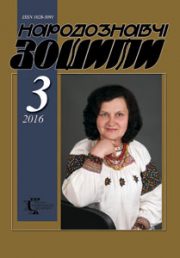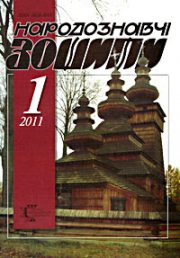The Ethnology Notebooks. 2018, 3 (141), 708–718
UDK 72.01
DOI https://doi.org/10.15407/nz2018.03.708
Tsiao Shubei, postgraduate student
at the Kharkiv State Academy of Design and Arts.
Mystetstv Street 8, 61002, Kharkiv, Ukraine.
Contacts: elena_olenina@mail.ru
Abstrakt. This article continues the study of children’s play spaces of China, and defines the problem of synthesis of Western European and Chinese artistic and aesthetic traditions in the contemporary design of China. The author studies the design solutions of some famous entertainment venues in Beijing, Shanghai and other Chinese megacities. Based on the compositional analysis of intra-district and city-wide game zones, the author concludes that in the context of globalization and active technological development for the design of China’s children’s play spaces this synthesis is most often used. It underlies at the heart of many artistic solutions and is carried out with certain design techniques, that the author revealed. This approach contributes to the mutual enrichment and interpenetration of eastern and western cultures by means of design, making the game space more universal and communicative.
Keywords: China, design of urban environment, children’s play spaces, synthesis, international, national, design approaches, design techniques.
Received 27.03.2018
References
Van, Lan. (2004). Detskaja ploshhadka zhilyh rajonov — adaptivnost’, dizajn. Huazhonge nauka i tehnika, 5, 41—42 [in Chin].
Lju, Jan. (2011). Kompozicija v kitajskom iskusstve kak vyrazhenie smyslov, obrazov i formy. V mire nauki i iskusstva: voprosy filologii, iskusstvovedenija i kul’turologi: sb. st. po materialam LXI mezhdunar. nauch.-prakt. konf., 6, (pp. 66—73). Novosibirsk: SibAK [in Russian].
Myn Van Chzhu Dan, Chzhao Ksyumyn Vanh Chzhu Shy. Zvukovoj dizajn parkov. Shk. grazhdan. stroitel’stva, Chzhjeczjan (Hanchzhou, 310058, Kitaj); Un-t Nac. fond estestv. nauk Kitaja (50178062); Soobshhestvo park saundskejp issledovanija [in Chin].
Lavrinenko, V.N., & Ratnikova, V.P. (eds.). Filosofija. (2010). Moskva: Jurajt [in Russian].
Cjao, Shubej. (2017). Kitajskaja hudozhestvenno-jesteticheskaja tradicija kak proektnaja osnova sovremennogo dizajna detskih igrovyh prostranstv KNR. Vіsn. Hark. derzh. akad. dizajnu і mistectv. Ser. Mistectvoznavstvo: zb. nauk. pr.,4, 29—39.
Cjao, Shubej. (2017, 9—12 zhovtnja). Tendencii v proektirovanii detskogo igrovogo prostranstva v Kitae. Zbіrnik materіalіv Mіzhnarodnih naukovo-metodichnih konferencіj «Pedagogіchnі aspekti pіdgotovki vikladachіv z vіzual’nogo mistectva ta dizajnu: suchasnіst’ і perspektivi» ta «Aktual’nі pitannja mistectvoznavstva: vikliki XXI stolіttja». Harkіv, pp. 349—350 [in Russian].
Qiao, Sh. (2016). Modern approaches in designing of children’s playgrounds in the context of development of the recreation industry. Visn. Khark. derzh. akad. dyzainu i mystetstv. Ser. Mystetstvoznavstvo: zb. nauk. pr., 5, 105—110.
Ho, Tynkhonh, Donh, Lyanh. (2017, 26—29 maja). Sad kak sredstvo reabilitacii psihicheskih rasstrojstv detej v rezul’tate deficita kontakta s zhivoj prirodoj. Materialy mezhdunarodnoj nauchno-prakticheskoj konferencii v oblasti izuchenija landshaftnogo dizajna.
Retrieved from: http://www.jchla.com/?Index_News—1255.html [in Chin].
Kompozicii v sadovo-parkovom iskusstve Kitaja. (2009). In Mudrost’ Kitaja.
Retrieved from: http://kitaia.ru/sadykitaya/kompoziciiv-sadovoparkovom-iskusstve-kitaya [in Chin].
Mao, Shujan. (2010). Filosofskoe predstavlenie ob igre i ee posledstvija dlja obrazovanija. Nankin .
Retrieved from: http://www.doczj.com/doc/e95049171ed9ad51f01df2dd.html [in Chin].
Materialy Mezhdunarodnoj konferencii po obrazovaniju v landshaftnoj arhitekture (SELA/CLAEC). (2017). Pekin.
Retrieved from: http://chinaed.ru/strana/kultura-kitaya.html [in Chin].
Se, Tonh, Fen, Byn. (2015). Tradicionnye jelementy kitajskogo sada.
Retrieved from: http://big.hi138.com/wenxueyishu/yishulilun/201406/437321.asp#.WWW7JojyjIU. 13. Czjan, Ksiao Chjen. (2015). Dizajn. Obsuzhdenie bezopasnosti Chongqing City Park. Detskaja ploshhadka. DOI: TU986.56.
Retrieved from: http://cdmd.cnki.com.cn/Article/CDMD-10635-1016703103.htm [in Chin].
Chzhao, Hai. Mezhpokolencheskaja jevoljucija detskogo otdyha v central’nom parke Shanhaja. Park sovremennogo goroda — izmenenija v Shanhae (1949—1978): materialy mezhdunar. nauch.-prakt. konf.
Retrieved from: http://www.jchla.com/?Index_Tuijian—5035.html [in Chin].
Juj, Czin’lun. (2017). Shanhaj Bol’shoj Medvedicy. Landshaftnyj dizajn. Kitajskij sad: akad. zhurn. Pekin. un-ta., 5, 29—34.
Retrieved from: http://www.xueshu.com/zgyl/201705/29415809.html [in Chin].






